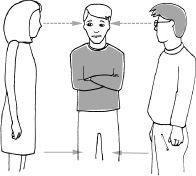The Definitive Book of Body Language (44 page)
Read The Definitive Book of Body Language Online
Authors: Barbara Pease,Allan Pease

Wearing makeup definitely adds to
a woman's perceived self-confidence.
The assistants who wore no makeup were rated worst on personal skills and personal presentation, and wearing glasses without makeup made little difference to the customers' attitudes and recall. Most female customers had noted when makeup was not being worn by the assistant, while most men could not recall whether she wore it or not. Interestingly, both women who wore makeup were thought to be wearing shorter skirts than those without makeup, demonstrating that makeup also presents a sexier image than wearing none. The bottom line here is clear—makeup gives a woman a more intelligent, confident, and sexier image and the combination of glasses and makeup in business has the most positive and memorable impact on observers, so having a pair of noncorrectable glasses could be an excellent strategy for business meetings.
For one of our television shows, we asked nine women to turn up for a series of interviews with both male and female interviewers. For half the interviews each woman wore lipstick, but they did not wear it to the other half. The interviewers' attitudes after the experiment quickly became clear—the women wearing red lipstick and using larger lip displays were seen as more interested in themselves and in men's attention, while women with reduced lip displays and muted or pastel colors were seen as more career-oriented and businesslike. The women with no lipstick were seen as more serious about work than men, but lacking in personal skills. Almost all female interviewers
had noticed whether the candidates wore lipstick or not, while only half of the men noticed when women were not wearing it. This means that a woman should wear larger displays of bright red lipsticks for going on dates, but smaller, more understated displays for business meetings. If she works in businesses that promote female image, such as clothing, cosmetics, and hairdressing, bright displays are seen as a positive because they sell female attractiveness.
The size of a briefcase is linked to perceptions of the status of its owner. Those who carry large, bulging briefcases are thought to do all the work and probably take work home because they are poor time managers. Slim briefcases say that the owner is only concerned with the bottom line and therefore has more status. Always carry a briefcase to one side, preferably in your left hand, which allows you to shake hands smoothly with your right hand without fumbling. If you're a woman, never carry a briefcase and handbag at the same time—you will be perceived as less businesslike and more disorganized. And never use a briefcase as a barrier between you and another person.
Regardless of what type of object or thing we choose to handle, wear, or smoke, there are special signals and rituals we display without awareness. The more of these objects we use, the more we signal our intentions or emotions. Learning how to read these signals gives you a second set of body-language cues to observe.
HOW THE BODY
POINTS TO WHERE THE
MIND WANTS TO GO
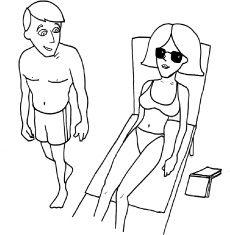
Often, the body goes one way while
the mind goes another
Have you ever been talking with someone and had the feeling he would rather be elsewhere than with you, even though he seems to be enjoying your company? A still photograph of that scene would probably reveal two things: first, the person's head is turned toward you and facial signals such as smiling and nodding are evident; and second, the person's body and feet are pointing
away
from you, either toward another person or toward an exit. The direction in which a person points his body or feet is a signal of where he would prefer to be going.
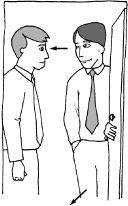
The man on the right indicating he wants to leave
The above illustration shows two men talking in a doorway. The man on the left is trying to hold the other man's attention, but his listener wants to continue in the direction his body is pointing, although his head is turned to acknowledge the other man's presence. It is only when the man on the right turns his body toward the other that a mutually interesting conversation can take place.
In any face-to-face meeting, when one person has decided to end the conversation or wants to leave, he will turn his body or feet to point toward the nearest exit. If this was a conversation involving you, it's a signal that you should do something to get the person involved and interested or else terminate the conversation on your terms, allowing you to maintain control.
We stated earlier that the distance between people is related to their degree of interest or intimacy. The angle at which people orient their bodies also gives nonverbal clues to their attitudes and relationships.
Most animals, if they want to fight with another animal, will signal this by approaching head-on. If the other animal accepts
the challenge, it will reciprocate by also standing head-on. The same applies to humans. If, however, the animal wants to check out the other animal at close range but doesn't intend to attack, it will approach side-on, just as friendly dogs do. And so it is with humans. A speaker who takes a strong attitude to his listener while standing straight and facing them directly is perceived as aggressive. The speaker who delivers exactly the same message but points his body away from the listener is seen as confident and goal-oriented but not as aggressive.
To avoid being seen as aggressive, we stand with our bodies angled at forty-five degrees to each other during friendly encounters to form an angle of 90 degrees.
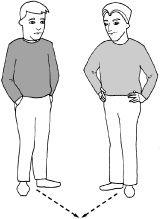
Each standing at forty-five-degree angles to avoid coming across as aggressive
The picture above shows two men with their bodies angled toward an imaginary third point to form a triangle shape. The angle formed indicates that a nonaggressive conversation is probably taking place and they are also displaying similar status by mirroring. The formation of the triangle invites a third person to join in the conversation. If a fourth person is accepted into the group, a square is formed and, for a fifth and sixth person, either a circle or two new triangles are formed.
In confined spaces like elevators, crowded buses, and subway trains, where it's not possible to turn your body away from strangers to a forty-five-degree angle, we turn our heads to the angle instead.
When two people want intimacy, their body angle changes from forty-five degrees to zero degrees; that is, they face each other. A man or woman who wants to monopolize a person's attention uses this position, as well as other courtship gestures, when they make their play. A man will not only point his body toward a woman, he also closes the distance between them as he moves into her Intimate Zone. To accept his approach, she need only orient her body angle to zero degrees and allow him to enter her space. The distance between two people standing in a Closed Position is usually less than in the open formation.
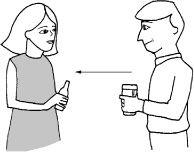
Direct Body Pointing in the Closed Position to attempt to get a captive audience
In addition to courtship displays, both may mirror each other's gestures and increase eye contact if they are both interested. The Closed Position can also be used between people who are hostile toward each other in order to issue a challenge.
Research has shown that men fear attack from the front and are more wary of a frontal approach, while women fear attack from behind and are wary of approaches from the rear. So never stand front-on with a male you have just met. He perceives it as aggression from a man and sexual interest from a woman. If you are male, it's acceptable to approach a woman from the front and eventually you can angle yourself to forty-five degrees.
The next illustration shows the forty-five-degree Open Position
taken by the first two people, which invites a third person to join in the conversation.
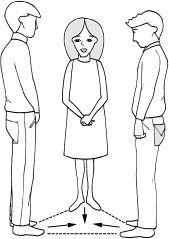
Open triangular position encouraging the entry of a third person
If a third person wants to join two others who are standing in a Closed Position, he'll be invited only when the other two angle their bodies to form the triangle. If the third person is not accepted, the others will hold the Closed Position and turn only their heads toward him as a sign of recognition; and they will probably give tight-lipped smiles.
